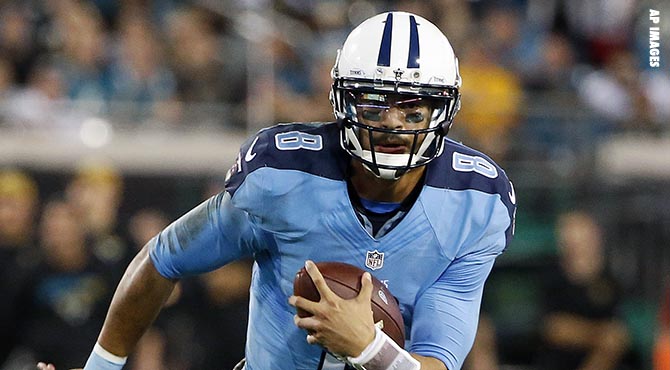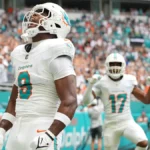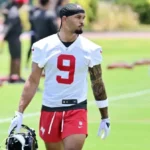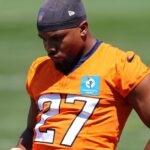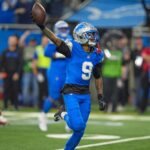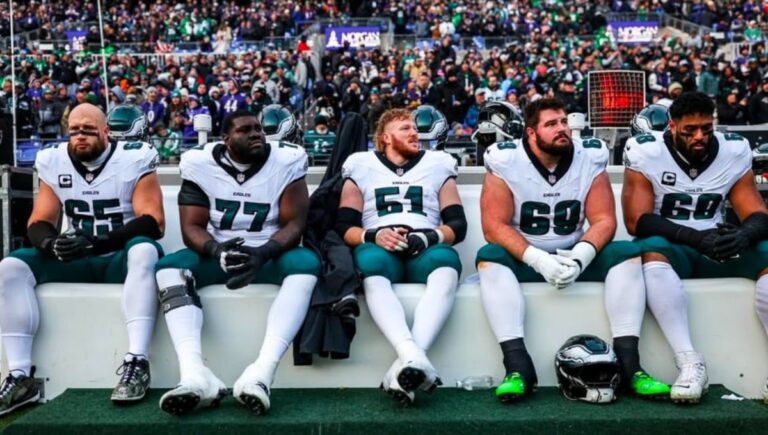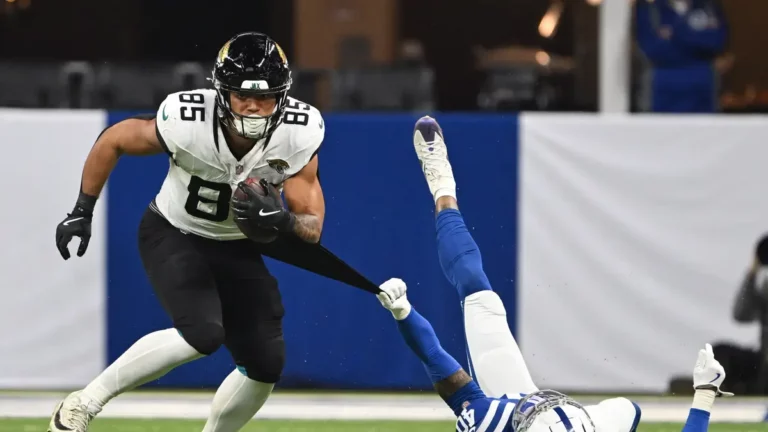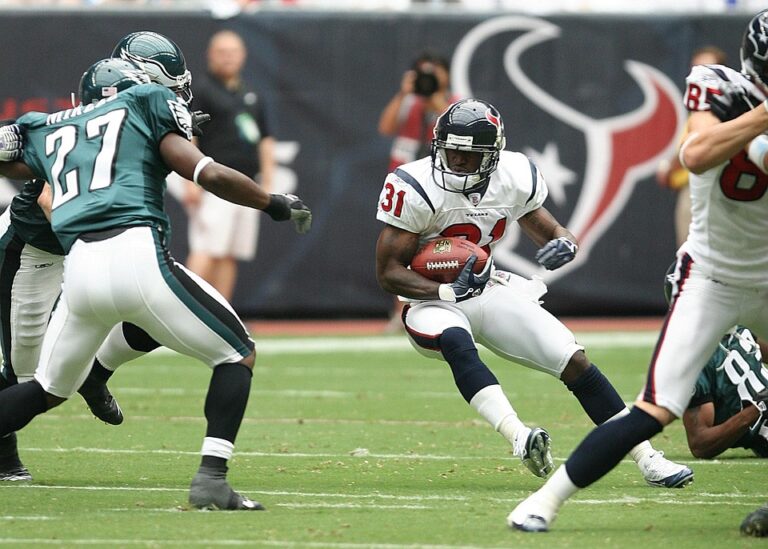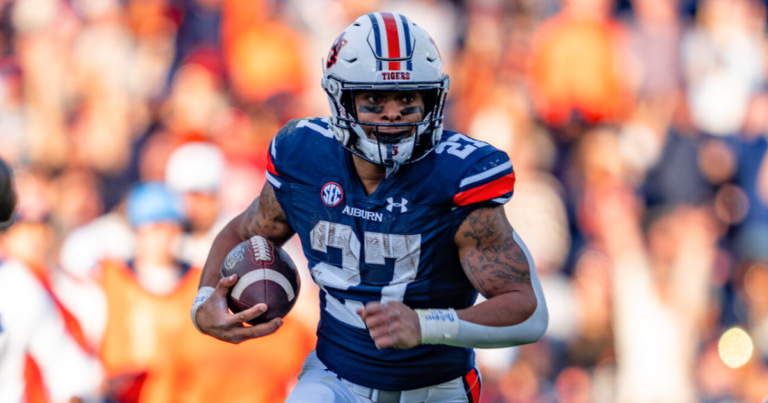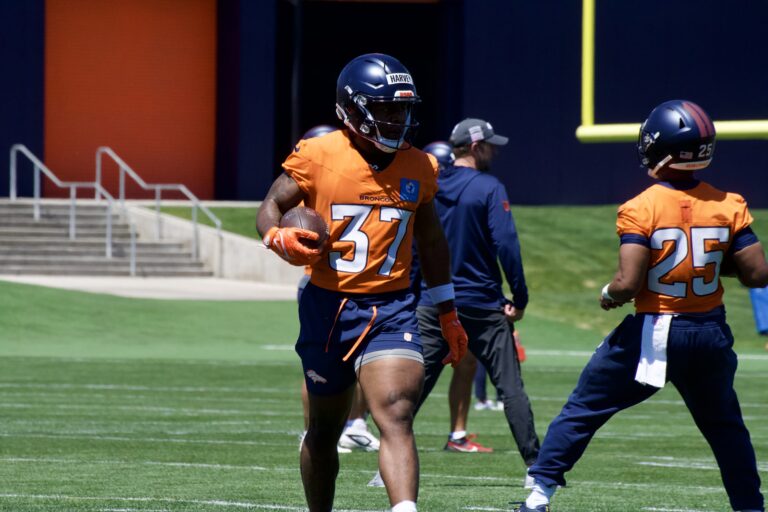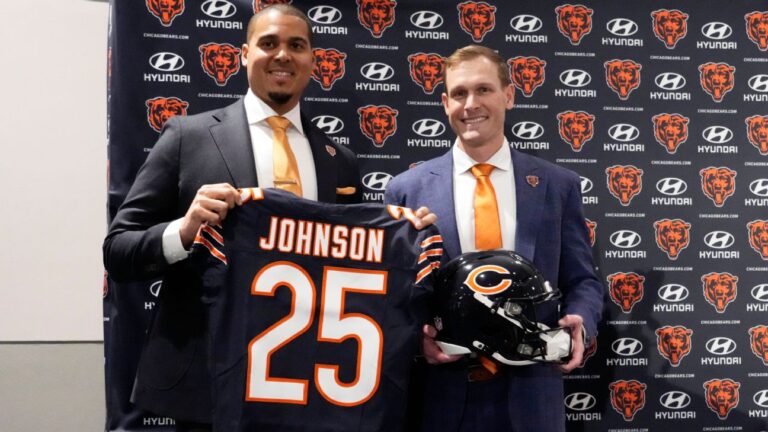Matt LaFleur:
Marrying the Run & Pass Games
2018 Tennessee Titans Fantasy Football Preview
Brought to You by Roto Street Journal

After being named HC of the Tennessee Titans, Mike Vrabel hired Matt LaFleur as the team’s OC. Though LaFleur had the same title with the Rams last season, he’ll actually be calling plays for the first time in his NFL career under the defensive-minded Vrabel. On why he hired LaFleur, Vrabel stated: “Matt brings an energy and an offensive diversity to our team. He is going to develop an offense that puts our players in position to have success. Matt has worked with some great offensive minds, helped game plan on those staffs and I am looking forward to seeing him take that next step as a play-caller.” Indeed, LaFleur has been groomed under some incredible play-callers, was a critical game-planning cog in some of the NFL’s most explosive recent attacks, and inherits an excellent cast to work with in Tennessee. Thus, his hire is essential to dive into from a fantasy lens.
General Background / Philosophy
Coaching History
Groomed Under the Game’s Brightest Young Minds
If I asked you to name the NFL’s brightest rising offensive coach, Kyle Shanahan and Sean McVay would undoubtedly gain consideration. Over the past two seasons, Shanahan’s Falcons and LaFleur’s Rams respectively topped the league in total points — LaFleur’s fingerprints are all over both attacks.
In fact, these two are the only coaches LaFleur has been groomed under since joining the NFL Ranks in 2008 at 29 years old, particularly Shanahan, who’s served as the coordinator of 8 of the 9 offenses in LaFleur’s coaching career. The new Titans OC began his NFL journey as Shanahan’s Offensive Quality Control coach with the Texans, and Kyle was so impressed with LaFleur’s work that he carried him along to his next gig in Washington, this time promoting LaFleur to QBs coach. The pair worked together for six more total seasons in these respective roles, which included four years with the Redskins, followed by two more in Atlanta.
LaFleur’s track record during this time is staggering. He had his fingerprints all over Robert Griffin‘s 2012 Rookie of the Year campaign, in which RGIII established Redskins rookie records in pass completions (258), passing yards (3,200), passing touchdowns (20) and rushing yards by a quarterback (815). He also was Matt Ryan‘s QBs Coach during Ryan’s career-best, MVP season (4,944 yards, 38 touchdowns, and 117.1 quarterback rating). The coach also drafted and groomed Kirk Cousins, and, despite working with Rex Grossman and a washed up Donovan McNabb in his other seasons, has only seen one attack tally below 4,000 total passing yards (Griffin’s ROY season, conveniently enough).
Unsurprisingly, Shanahan has nothing but praise for LaFleur. When asked last offseason if LaFleur was ready to call his own plays as he transitioned to the Rams’ OC, Shanahan replied: “Yeah, he’s been ready for a while.”
“They’re getting a hell of a coach,” Shanahan continued. “Matt understands the game. He played college quarterback. He knows a lot about that position. He knows the run game, he knows the pass game, he knows how to tie them together.“
We’ll dive into this “tying together the pass and run games” more below, considering LaFleur’s system hinges on this. In fact, we saw that in full-blown action with the Rams and Todd Gurley in 2017, LaFleur’s only coaching stop away from Shanahan. Of course, here LaFleur served under perhaps the only young coach who can rival Shanahan in terms of offensive prowess: Sean McVay.
While McVay was the primary play-caller, LaFleur was reportedly integral in game-planning and often depended upon in key situations. Just like Shanahan, McVay has nothing but praise for his former OC.
“I think he’ll be great,” McVay said of LaFleur. “Matt is a great coach. It is a big loss for us… Matt is a great teacher, a great leader, a great motivator. I think he sees the game from the quarterback’s standpoint just from his history of playing.
“He’ll do an excellent job putting guys in the right spot. I know he is excited about filling out the rest of the staff with coach Vrabel, and figuring out how they can bring out the best in those players but I think him and Marcus will work very well together.”
Simply put, you couldn’t ask for better mentors or a more extensive track record leading into a play-calling job than what LaFleur brings. Of course, neither of these guarantee he’ll actually succeed once the play-calling responsibility is all his, but he’s as well-prepared as possible.
/cdn.vox-cdn.com/uploads/chorus_image/image/59354877/usa_today_10357410.0.jpg)
Scheme / System
Merging the Run and Pass Games
LaFleur’s offense centers around one goal: merging the running and passing games so the attack is a well-oiled, unpredictable machine.
He said as much with the Rams, calling for “a strong marriage with our running game and our passing game so that a defense can’t just tee off on a guy. The idea is to have a balanced attack and keep a defense guessing.” The results speak themselves with Todd Gurley the reigning Fantasy MVP, while the Rams led the NFL in scoring a year after ranking dead last.
Unsurprisingly, LaFleur is going back to the well with the Titans. When asked to describe his offense, LaFleur replied, “First of all, it really all starts with our run game and having plays that play off our run game. I think that’s how we’re going to try to have a strong marriage between the run and the pass, so that to a defense it might look like, ‘Oh, here comes another run,’ and it’s a play-action pass off that run or whatnot.”
This “run/pass game marriage” hinges around two staples: screens and play action passing.
Here’s a prime example of both:
/cdn.vox-cdn.com/uploads/chorus_asset/file/10628871/LaFleur__Loads_of_trickery_.gif)
The creative run-game is also highlighted above, as the play-action stems from an end-around fake. As the defense bites and sells out to stop the run, Gurley suddenly finds himself with ample space and multiple blockers in front. Let’s dig into both offensive staples a bit more:
Screens:
Screens were a staple under the Rams last season, with Jared Goff throwing for the third-most yards in the NFL off screens (308), trailing only Drew Brees and Andy Dalton. Goff’s 29 screen-pass completions – on 30 attempts – were fourth-best in the league. Expect this to transfer over to Tennessee, who were effective in the screen game last season as Mariota completed 17-of-21 screen passes for 185 yards and three touchdowns. They simply didn’t dial up what was working, which will change under LaFleur. Vrabel seems particularly intrigued by screen concepts, noting:
“I think if you look around the league, there’s a lot of teams that are really good at screens,” Vrabel said. “That’s something that I’m going to continue to harp on our coaches about, to make sure that we can run these things. If Tom Brady can throw screens in a playoff game and gain a bunch of yards, then Marcus (Mariota) should be able to throw screens, and help him out with some of these throws that are easy access throws.
“But they’ve got to be blocked correctly. It’s just one guy away and it takes all 11 – whether it’s a block, or throwing around a defender that’s clean-rushing in the pocket, or the guy catching the ball.”
Good thing the Titans boast one of the most promising, athletic young lines in football. Expect screens to be dialed up repeatedly, and for Dion Lewis and the WRs corps to thrive with blockers in space.
Play Action:
In addition to screens being a major part of the “run / pass game marriage,” play action is another staple. Establishing a strong running presence gets the safeties and linebackers cheating, opening up opportunities down the seams and in the screen game when they bite on the fake, while creating one-on-one chances on the outside. The Titans already ran a healthy amount of play action — 12th highest percentage in the league at 23.5% of Mariota’s drop-backs plays.
Yet, LaFleur’s Rams used play-action even more than the Titans last season (closer to 30 percent). And if you want to go back even further, LaFleur used play-action a staggering 42 percent of rookie Robert Griffin III’s dropbacks during his rookie season, per PFF. Matt Ryan also led the league in play-action passing during his 2016 MVP Season, and its long been a staple of Kyle Shanahan‘s attack. Point being – LaFleur loves the play action and knows how to execute these concepts at the highest level.
This is ideal, because Mariota absolutely thrives on play-action based throws. His 122.8 QB Rating and 11.2 yards per attempt on play-action throws ranked first in the NFL, and 9 of his (paltry) 13 TDs came off of play-action throws (again, mind-numbingly ran only 23.5% of the time despite his success).
This pathetic play-calling must and will change under LaFleur, who vows to feed into his team’s strengths: “We’re going to try to tailor our offense to our player’s ability.” If true, expect the Titans to use play-action on 30-40% of their throws, and Mariota to flourish.
Overall:
In general, LaFleur aims to not only be unpredictable, but also aggressive. In fact, when asked about his overall offense, LaFleur pointed to the Super Bowl as a perfect example of why offensive aggression is important. The Rams often had a home run option baked into their play, using bunch formations, tight receiver splits, and the aforementioned play action to break guys free for the deep ball. LaFleur sounds intent on keeping these downfield concepts:
“It’s extremely difficult to dink and dunk all the way down the field. Defenses are just too good,” LaFleur said. “Statistically, the teams are getting the chunk plays — the explosives — are the teams that are going produce more yards and more points.”
In summary, expect an offense featuring a heavy dosage of screens, play-action passing, and downfield throws, all coming off the back of a well-established running game.
“
First of all, it really all starts with our run game and having plays that play off our run game. I think that’s how we’re going to try to have a strong marriage between the run and the pass, so that to a defense it might look like, ‘Oh, here comes another run,’ and it’s a play-action pass off that run or whatnot.” – Matt LaFleur on his main offensive goal
Passing Game Impact
Quarterbacks
- Past Production
- *Note – LaFleur has only served as OC once, and never called his own plays. To illuminate the trends of McVay and Shanahan, we’ve posted the past two seasons of stats
-
- 2016 – Matt Ryan: 373/543 (69.9%), 4933 yds, 38 TDs, 7 INTs
- 2017 – Jared Goff: 296/477 (62.1%), 3804, 28 TDs, 7 INTs
Summary:
Both Shanahan and McVay’s offenses feature oodles of play-action, screen-passing, and calculated deep shots. Ball-security is paramount despite seeking the “chunk play,” so interceptions often remain low. With Matt Ryan at his disposal, Shanahan and LaFleur took the air far more frequently, even if the concepts were largely similar with Goff.
2018 Outlook – LaFleur’s Offense Tailor-Made to Mariota’s Strengths

The overall fantasy fortunes of the Titans obviously depend upon Marcus Mariota. Thankfully, after rotting in “Exotic Smashmouth” for two seasons, Mariota has, by far, his best chance at truly realizing his ceiling with LaFleur.
For one, LaFleur is prioritizing their relationship, and ensuring Mariota isn’t bashful in explaining what he enjoys and feels comfortable running. As the new OC stated:
“Our communication is going to be absolutely critical to all of our success here,” said LaFleur. “I reiterated with him the importance of — if there’s something you don’t feel comfortable doing, I want you tell me. I know it’s kind of against his nature because he’s such a good person. I just don’t want him to hold back on anything.”
McVay, who’s been with LaFleur his entire coaching career, similarly expects a relationship-centric approach:
“When I see Marcus from afar, (he has) kind of an even-keel demeanor, which I think serves you well as a quarterback, and Matt is very similar. They’ll be on the same page, but I think the best thing about Matt is, he’s going to figure out what Marcus feels most comfortable with, and do that.
“He is not going to put him in situations he doesn’t feel comfortable with, and that is what good coaches do. Matt is an excellent coach, and he’s excited about the opportunity he has to lead that offense.”
Even more promising, what LaFleur is likely to dial up aligns perfectly with Mariota’s strengths.
Primarily, this will be the play-action game. As mentioned, LaFleur’s Rams ranked among the highest in the league in play action percentage (just under 30%). Moreover, he rode play-action passing to facilitate RGIII’sRookie of the Year 2012 campaign (42% play-action), as well as Matt Ryan‘s 2016 MVP Season (30%, highest in league). Meanwhile, Mariota’s 122.8 QB Rating and 11.2 yards per attempt on play-action throws ranked first in the NFL, and 9 of his (paltry) 13 TDs came off of play-action throws — even though the Titans ranked 19th in play-action throws, despite Mariota’s obvious success. This will change considering LaFleur’s promise to tailor the offense to Mariota’s strengths, plus his established love for play-action.
Beyond the play-action, Mariota will likely execute a bevy of screen options — the Rams rode this to massive success in 2018, leading the league in YAC by a long stretch. Meanwhile, Mariota was successful in executing screens, going 17-of-21 screen passes for 185 yards and three touchdowns. The team simply didn’t dial them up nearly enough.
Additionally working in Mariota’s favor is the deep-ball. LaFleur vowed to be aggressive, noting “It’s extremely difficult to dink and dunk all the way down the field. Defenses are just too good. Statistically, the teams are getting the chunk plays — the explosives — are the teams that are going produce more yards and more points.” Though not often deployed, Mariota’s deep-ball has progressed tremendously since he joined the league:

In fact, according to the Brick Wall Blitz — a project dedicated to analyzing deep-ball statistics: “Mariota was 2nd in overall deep-ball accuracy, 2nd in accuracy under pressure, 5th in accuracy on throws to tight windows, and 3rd in open window accuracy. Despite playing in a Mike Mularkey coached Tennessee Titans offense that produced the 5th most accurate incompletions, Mariota had zero inaccurate completions.”
LaFleur has also noticed Mariota’s calmness under pressure, stating, “You can see the talent that he possesses. There are three prerequisites to playing the [QB] position: You have to be a natural thrower, you better be fearless in the pocket, be able to stand in there. He has all three.”
All of this addresses Mariota’s arm-talent only. We can’t forget Mariota’s freakish athleticism, as the signal-caller led his class in every single running and jumping category in the 2015 Combine. Given his sterling track record with read-options and RPOs at Oregon, Mariota has thrived when asked to make plays on the run or utilize his legs. LaFleur has obviously noticed, and plans to capitalize:
“The hardest thing is you don’t ever want to take that element, that creativity, his ability to create off schedule,” LaFleur said. “You never want to take that away from a quarterback that has the athleticism that Marcus has.”
Considering the passing game will be tailor-made to Mariota’s strengths, while his athleticism will be maximized, Mariota drips in QB1 appeal for 2018. His 130 overall, QB17 ranking emphasizes just how deep QB will be in 2018, and why waiting is essential. Spend 11th, 12th, and 13th round picks on Mahomes, Mariota, and Trubisky or Tyrod Taylor, and you’ll land at least one breakout QB1 (if not multiple)
Wide Receivers

- Past Production
-
- 2016 – Julio Jones (14 GP): 83 rec (129 tgts), 1409 yds, 6 TDs
-
- 2017 – Robert Woods (12 GP): 56 rec (85 tgts), 781 yds, 5 TDs (74 rec, 1041 yd, 7 TD pace)
- Cooper Kupp: 62 rec (94 tgts), 869 yds, 5 TDs
-
-
Summary:
As explored, LaFleur is heavily tied to the Shanahan Tree, an offense which operates best with an “Alpha Target Hog” X-Receiver on the outside (think –Julio Jones, Andre Johnson, and even Pierre Garcon for stretches). This style of WR will be peppered with a bevy of intermediate, YAC-creating routes that churn a defense down, before attacking deep for the explosion plays, vacuuming looks and attacking defenses at every single level of the field. WR screens are also a staple. As seen in LA, LaFleur will move his WRs all over the spot, using bunch formations, tight receiver splits, and the aforementioned play action to break guys free for the deep ball — a homerun option often seemed baked into every play.
2018 Outlook – Corey Davis to Assume Alpha X Status
The current Titans WRs depth chart seems uninspiring, consisting of an unproven Corey Davis, the reliable but uninspiring Rishard Matthews, and a complete unknown in Taywan Taylor. Yet, all three offer upside in what projects to be a highly creative attack.
Davis is the obvious top choice of the bunch. At a long and strong 6’3″, he certainly has the build, in addition to the ball-skills and route-running savvy, to emerge as a true “Target Hog” — all were on display during a flat out dominant 98 yard, 2 TD Wildcard performance. Davis made leaping grabs and one handed snares, plus moved well after the catch, looking all the parts of a No.1 threat. This has reportedly carried over in to 2018, as Davis was a star at Titans OTAs, “catching the ball with ease,” “long-striding all over the practice field,” and “turning up the field” with fiery acceleration. He also reportedly put in extra time with Marcus Mariota and at the JUGs machine, and seems committed to his WR1 path. While dominating in shorts shouldn’t be overvalued (we’ve seen plenty of OTA All Stars who never emerge), Davis is healthy and flashing the “Talent” that made him the all-time NCAA leader in career yardage (5,278) and worth the No.5 overall pick as a potential passing-game centerpiece. He remains an injury risk after being plagued all 2017, but offers insane breakout upside for his late 6th, early 7th price.
Beyond Davis, old reliable Rishard Matthews has the most established chemistry with Mariota on his side. Matthews is excellent in contested situations and runs with power, but most importantly has proven reliable on key third downs. Since he lacks anything truly “special” physically, Matthews will never be a flashy fantasy pick. Yet, he’s almost sure to outperform his 150 ADP, even if I prefer going for lottery stabs in that range.
More intriguing might be Taywan Taylor, who’s a complete mystery after rotting in “Exotic Smashmouth” last season. Yet, he was extremely explosive in college, with a game very similar to Robert Woods who thrived with LaFleur last season. Taylor has stuttering quicks and is dangerous on the short routes out of the slot, yet can plant-and-go vertically as well. LaFleur will undoubtedly capitalize on this versatility, as Taylor thrived on bubble screens, jet sweeps, and designed short YAC plays — all staples in this creative attack. Even if he’s currently going undrafted, Taylor should absolutely be on your radar.
Tight Ends

- Past Production
- 2016 – Jacob Tamme & Austin Hooper = disgusting timeshare
-
- 2017 – Gerald Everett & Tyler Higbee = garbage
-
Summary:
Over the past two seasons, both of LaFleur’s teams deployed hideous TE committees. Notably, these teams lacked any semblance of talent at the position, and LaFleur has seen plenty of quality TE usage in previous stints,. Throughout LaFleur’s history in Washington and even early on in Houston, Owen Daniels, Chris Cooley, and even Fred Davis served as the clear-cut No.2 targets in their offenses, behind only an Alpha Hog. In fact, Daniels and Davis both were on 1,050+ yard paces before their injuries. In general, the TEs have been used frequently off play-action, gaining chunk 15-20 yarders down the seams. TE screens are also frequently called. On the negative, TEs have seen their usage decline near the stripe, where LaFleur’s teams, under both Shanahan and McVay, grow decidedly more run-heavy.
2018 Outlook – A Downswing for Delanie?
Delanie Walker has been the epitome of consistency since joining the Titans five years ago. Although Tennessee has finished 21st or lower in pass attempts in each of these seasons (including 28th the past two years), Walker’s topped 63 receptions and 800 yards in all but one year. In fact, over the past 5 years, no TE has more receptions than Walker, who’s also appeared in 15+ games each season.
Without any star WRs, Walker’s consistently served as the teams’ go-to guy, especially on third downs. He can streak down the field, with the same 4.54 40 yard dash speed of Corey Davis, is an incredibly powerful tackle-breaker, and has among the most reliable hands in the league. He certainly doesn’t lack for confidence, stating, “‘Honestly, I feel like I’m the best tight end in the league in all phases,’ Walker said this week. ‘Blocking, run blocking, catching the ball, breaking tackles, stuff like that.'”
However, there’s room for concern. He’s no spring-chicken at age 34, even if Walker’s shown no signs of decline. Though his toughness can’t be questioned, Walker’s played through a litany of nagging aches and pains over the past few seasons. He insists he feels as good as ever, saying, “You can write about it and tell them how well you think I look out there, but I feel great. At the end of the day, until I feel like someone can take my spot, I’m going to keep playing. I feel like I can play for four years. As long as I still feel that way and I’m moving as fast as I am on the field, and making plays, I’m not going to stop.” Still, the cliff can come fast.
TEs have also been largely irrelevant in LaFleur’s most recent offenses, though he’s also lacked a talent of Walker’s nature. If LaFleur is as bright as McVay and Shanahan state, he’ll recognize Walker is, at minimum, his second best receiving threat, and utilize him as such. Both of LaFleur’s mentors made yardage beasts out of less-athletic guys like Owen Daniels and Chris Cooley, so another 70-catch, 800 yard season seems likely for Walker — an incredible floor at such an inconsistent position. Still, the ceiling feels capped as Walker ages and exciting talents emerge around him with proper usage.
Run Game Impact
“It all starts with the running game”
-LaFleur
Running Backs

- Past Production
- 2016 – Committee w/ lead horse – Devonta Freeman: 1541 YFS, 13 tot. TDs, 54 rec (65 tgts)
- Tevon Coleman 941 YFS, 11 tot. TDs, 31 rec (40 tgts)
- 2017 – Epic Workhorse – Todd Gurley: 2093 YFS, 19 tot. TDs, 64 rec (87 tgts)
Summary: LaFleur’s main goal remains “marrying the run and pass games,” which means establishing the backfield presence is crucial. He hails from the Shanahan tree, meaning he should frequently use the outside and inside zone game. Additionally, both systems peppered the backs with targets, both in the screen game and on quick routes out of the backfield on play action (Gurley led the Rams in receptions last season, while ranking second in receiving yardage and TDs). Whether inherited by a true workhorse or divided into a committee, LaFleur’s past backfields have consistently been responsible for 35-40% of the entire offense, creating enormous volume for the taking.
Saints-Lite: A Committee You Can Trust
Considering the core of LaFleur’s offense is a “marriage between the pass and run games,” actually establishing a backfield presence is a critical first step. LaFleur noted as much, stating, “First of all, it really all starts with our run game and having plays that play off our run game….There’s always going to be a foundation, and the foundation really starts with our running game and how we tie the pass game to our running game,” LaFleur said. “We want to keep the defense off-balance, you have to keep them guessing. If you have plays that start out looking the same that are different, it keeps the defense guessing.”
Thankfully, LaFleur has two highly talented backs at his disposal to establish this base. Both Derrick Henry and Dion Lewis offer incredible and varied skill-sets, and LaFleur unsurprisingly expects to capitalize on both, noting: “Until you get the pads on and really get going through preseason, I look at them both as 1A and 1B. I feel confident in both of those guys. They both bring a little bit different qualities to what they do. But I think we’ve got two really good backs that we’re excited about.”
Clearly, we appear headed for a committee — most often a puke-inducing word for fantasy football owners. Yet, with the backfield serving as this offense’s heartbeat, enough volume should be available for both backs to thrive. Shanahan’s offenses have always funneled through his zone-running game and the play-action / screens that stem off it, and clearly Todd Gurley was the engine in Los Angeles in 2017. Anywhere from 2,300-2,600 total yards and 15-25 total TDs should be up for grabs in the Tennessee backfield, especially considering the lack of proven receiving talent outside of Walker. In fact, I could see both backs topping 1,200 total yards, with Henry hovering around 10+ TDs while Lewis feasts on 60+ receptions — workhorse-esque numbers, at a committee price (Henry = late third, early 4th ADP; Lewis = 6th Round).
Plus, both do carry true-workhorse upside. Lewis is far-and-away a more dangerous receiver, yet also comes with incredible run-game instincts, particularly his patience with a mini-Le’Veon Bell style of game. He also is sneakily powerful with a strong lower body that easily gains leverage given his small stature, which also aids him in sneaking behind his massive line. If anyone were to flat-out steal this job, it’d be Lewis — his versatility would is better-suited to create the unpredictability and fast-pace LaFleur craves.
Yet, Lewis carries significant injury risk. Prior to last season, Lewis had only played in 14 of 32 possible games (2015-16), dealing with a slow-recovering ACL surgery. He wasn’t even in the league in 2013 or 2014, struggling with a brutal broken fibula and a lack of interest following his recovery. Thus, Henry could see the full offensive reigns handed over at some point in 2018. While not the smoothest receiver, Henry’s not particularly bad either, rarely seeing enough opportunity in this aspect. He can read blockers well on screens, and remains tough to tackle in space. Plus, as a runner, we’ve been Henry truthers since his Von Miller – equivalent Combine Performance. He’s a freight train that can move, and while he’s yet to consistently plow forward and too-often bounces runs outside, Henry’s flashed his workhorse potential on numerous occasions (most recently, a 191 yard, TD Wildcard Playoff feasting). Prior to Lewis’ signing, we had Top-10 Overall hopes once Murray was finally released, and Henry still drips in this upside if the backfield becomes fully his through injury.
Should both backs remain healthy, I still like their chances at massive fantasy value even in a timeshare. The “committee stench” will drop their prices beyond what’s reasonable, especially considering the backfield is the spine of LaFleur’s entire offense — a huge amount of RB volume will be here for the taking (ala the Saints last year). Plus, this line is among the most balanced in the league, bookended with two first-round tackles in Jack Conklin and Taylor Lewan while receiving consistent play along the interior from Josh Kline, Ben Jones, and Quinton Spain. They’e graded out as Pro Football Focus’ 5th and 1st best lines the past two seasons, and are athletic enough to execute LaFleur’s screen-based passing game, while strong enough to pave mauling holes to establish the play-action later.
Summary
New Titans OC Matt LaFleur has been groomed under the NFL’s two brightest young offensive minds in Kyle Shanahan and Sean McVay, with the ’16 Falcons and ’17 Rams — the last two offenses LaFleur’s been a part of — both leading the league in scoring. Though he’s never called his own plays, LaFleur still hopes to bring this type of spark to a Titans offense that lacked a pulse last year after “Exotic Smashmouth” was predictably less “Exotic” in Year Two.
Thankfully, LaFleur’s major offensive staples fit this roster perfectly. His main goal is an “aggressive” offense that ultimately “marries the run and pass games” so his offense is unpredictable. This mean a bevy of play-action and screen concepts stemming from a well-established run game.
With the backfield as this offense’s heartbeat, Derrick Henry and Dion Lewis will be crucial to the Titans and LaFleur’s offensive success. Indeed, they come with a “committee stench,” but history suggests roughly 2,100-2,600 total yards and 15-20 TDs will be generated out of this backfield alone, giving both backs ample volume to feast upon for productive campaigns (ala last year’s Saints). Both backs also benefit from one of the Top-5 lines in the NFL, who are strong enough to push the pile and create massive run lanes, yet athletic enough to get out into space for the screen game. With Henry falling to Round 4 now, while Lewis hovers in Round 6, both backfield pieces are intriguingly priced.
Meanwhile, Marcus Mariota is set up for his most professional success by a mile, especially considering LaFleur’s dependency on the play-action. Mariota was PFF’s highest graded play-action thrower in 2017 (122.8 QB Rating), logging 9 of his pathetic 13 TDs on play-action concepts, despite the team running it a meager 23.5% of the time. Expect that number to shoot upwards, along with his TDs. Mariota also throws a pretty deep ball, and will benefit from LaFleur’s seeking of the big play. LaFleur also has experience capitalizing upon QB-mobility (RGIII’s 800+ rushing yards, anyone?), and doesn’t plan to reign in Mariota’s unique athleticism.
The main question is who’ll be hauling Mariota’s catches in. Besides a heavy dosage of RB screens, expect Corey Davis to be heavily involved. LaFleur hails from the Shanahan Tree, notorious for breeding “Target Hog” Alpha – X receivers (Andre Johnson, Julio Jones). Despite an injury marred rookie season trapped in a horrendous system, Davis is still a 6’3″ monster who can dominate after the catch and run routes at every level. There’s upside he emerges as the next Alpha X, making his 7th Round ADP a bargain right now. Meanwhile, Taywan Taylor is an exciting “Penny Stock,” as he dominated on the screens and bubble routes LaFleur loves dialing up, and, along with his excellent short-area quickness, can bring some real verticality to the slot. Rishard Matthews remains the most established option here, and his dependability means he’ll likely be undervalued, even if I prefer higher upside stabs with my 10th RD picks.
Beyond the wideouts, Delanie Walker shouldn’t struggle to reach 800 yards and 65+ catches for the fifth time in sixth years; even though LaFleur’s minimally used his recent TEs, he’s lacked any talent that can even approach the 34-year old Walker. Owen Daniels and Chris Cooley both logged over 800 yards and even were on pace for 1,000, as the TE benefits greatly from the space created down the seams with heavy play action. Expect Walker to bring a floor few TEs can match, making his 7th Rd ADP reasonable as well.
As with any new offense — especially a first time play-caller — growing pains should be expected. Still, LaFleur is a former QB himself, and will know how to simplify the game for Mariota. After learning from the best, and inheriting a roster that fits his staples perfectly, LaFleur seems primed to become one of the NFL”s latest exciting young offensive minds (alongside Matt Nagy and John DeFilippo).
More Coaching Carousels
2018 Minnesota Vikings Fantasy Football Preview: DeFilippo and Cousins Send Offense Soaring
Matt Nagy – The 2018 Sean McVay? Bears Set for Fantasy Football Fireworks
2018 Arizona Cardinals Fantasy Football Preview: Mike McCoy to Carry Bruce Arians’ Torch?
2018 Colts Fantasy Football Preview: Frank Reich to Maximize Luck, Hilton, and Hynes
2018 Oakland Raiders Fantasy Football Preview: Cooper, Lynch to Thrive Under Jon Gruden?
